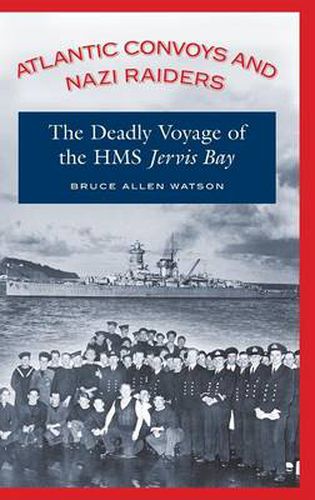Readings Newsletter
Become a Readings Member to make your shopping experience even easier.
Sign in or sign up for free!
You’re not far away from qualifying for FREE standard shipping within Australia
You’ve qualified for FREE standard shipping within Australia
The cart is loading…






In November of 1940, the German pocket battleship Admiral Scheer attacked British Convoy HX-84. The merchant cruiser HMS Jervis Bay, a converted passenger liner that was the convoy’s only escort-armed only with antique 6-inch guns-charged the Nazi raider. While the Jervis Bay did not stand a chance of surviving the battle, her crew’s fatalistic bravery inspired awe in all who witnessed the fight. Watson recounts how the Scheer’s 11-inch guns turned the ship into a burning hulk in twenty-two minutes, but most of the convoy escaped.
In November of 1940, the German pocket battleship Admiral Scheer attacked British Convoy HX-84. The Armed Merchant Cruiser HMS Jervis Bay, the only escort and mounting antique 6-inch guns, charged the Nazi raider. While the Jervis Bay did not stand a chance of surviving the battle, her crew’s fatalistic bravery inspired awe in all who witnessed the fight. Watson describes how the Scheer’s 11-inch guns turned the converted passenger liner into a burning hulk in twenty-two minutes, but most of the convoy escaped.
How did this confrontation come to pass? Both the necessity of arming a passenger liner and pretending it was a warship, and the building of the Admiral Scheer and her sister ships for the express purpose of commerce raiding, find their roots in the events, political decisions, re-armament polices, war plans, naval traditions, and blunders that arose in pre-war Britain and Germany. But this event holds a significance beyond the battle itself. The sinking of the Jervis Bay symbolizes the end of an era in naval warfare. The Armed Merchant Cruisers of the Second World War inherited a long, sometimes noble and sometimes ignoble history. Long employed in blockade or patrol duty, armed merchant cruisers ventured out for the first time to escort convoys, a defensive duty for which they were eminently unsuited, and for which the Jervis Bay paid a fearful price.
$9.00 standard shipping within Australia
FREE standard shipping within Australia for orders over $100.00
Express & International shipping calculated at checkout
In November of 1940, the German pocket battleship Admiral Scheer attacked British Convoy HX-84. The merchant cruiser HMS Jervis Bay, a converted passenger liner that was the convoy’s only escort-armed only with antique 6-inch guns-charged the Nazi raider. While the Jervis Bay did not stand a chance of surviving the battle, her crew’s fatalistic bravery inspired awe in all who witnessed the fight. Watson recounts how the Scheer’s 11-inch guns turned the ship into a burning hulk in twenty-two minutes, but most of the convoy escaped.
In November of 1940, the German pocket battleship Admiral Scheer attacked British Convoy HX-84. The Armed Merchant Cruiser HMS Jervis Bay, the only escort and mounting antique 6-inch guns, charged the Nazi raider. While the Jervis Bay did not stand a chance of surviving the battle, her crew’s fatalistic bravery inspired awe in all who witnessed the fight. Watson describes how the Scheer’s 11-inch guns turned the converted passenger liner into a burning hulk in twenty-two minutes, but most of the convoy escaped.
How did this confrontation come to pass? Both the necessity of arming a passenger liner and pretending it was a warship, and the building of the Admiral Scheer and her sister ships for the express purpose of commerce raiding, find their roots in the events, political decisions, re-armament polices, war plans, naval traditions, and blunders that arose in pre-war Britain and Germany. But this event holds a significance beyond the battle itself. The sinking of the Jervis Bay symbolizes the end of an era in naval warfare. The Armed Merchant Cruisers of the Second World War inherited a long, sometimes noble and sometimes ignoble history. Long employed in blockade or patrol duty, armed merchant cruisers ventured out for the first time to escort convoys, a defensive duty for which they were eminently unsuited, and for which the Jervis Bay paid a fearful price.